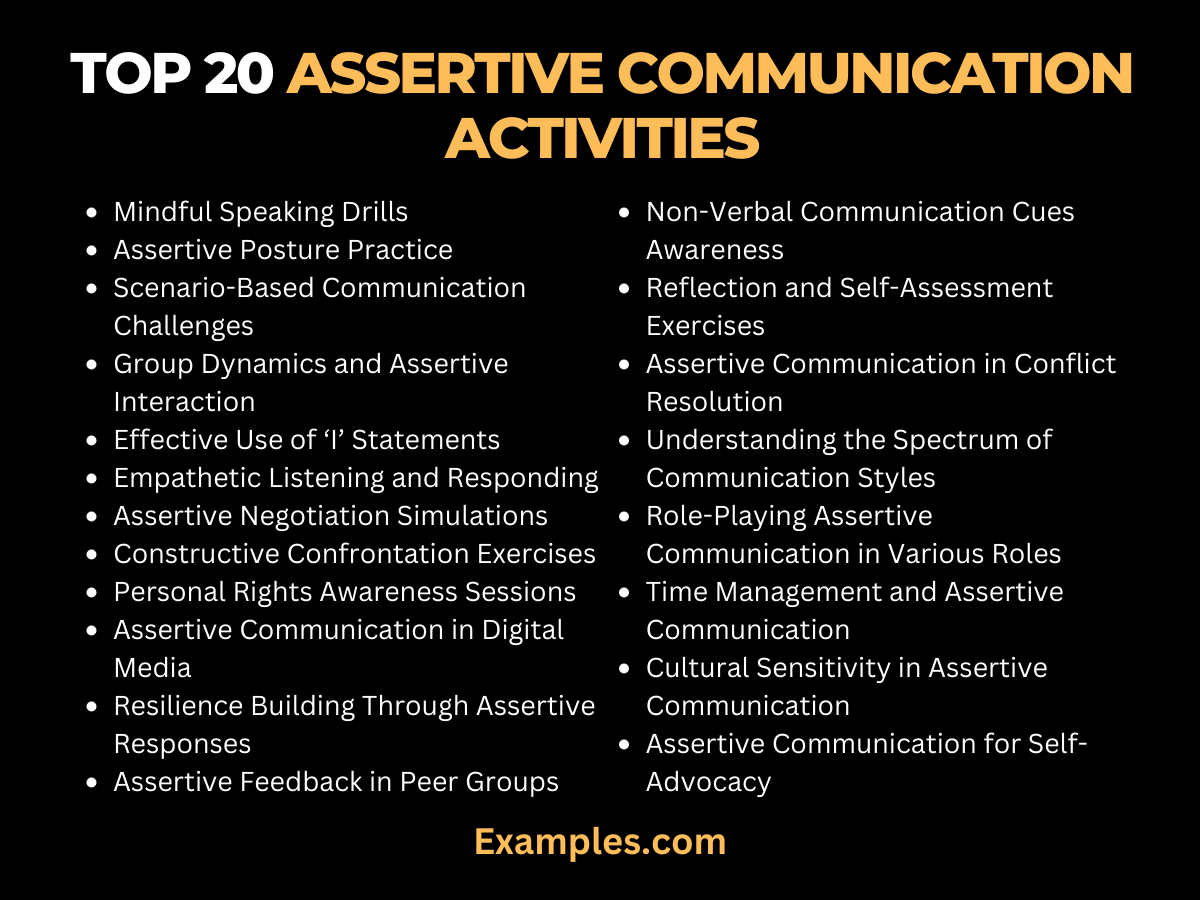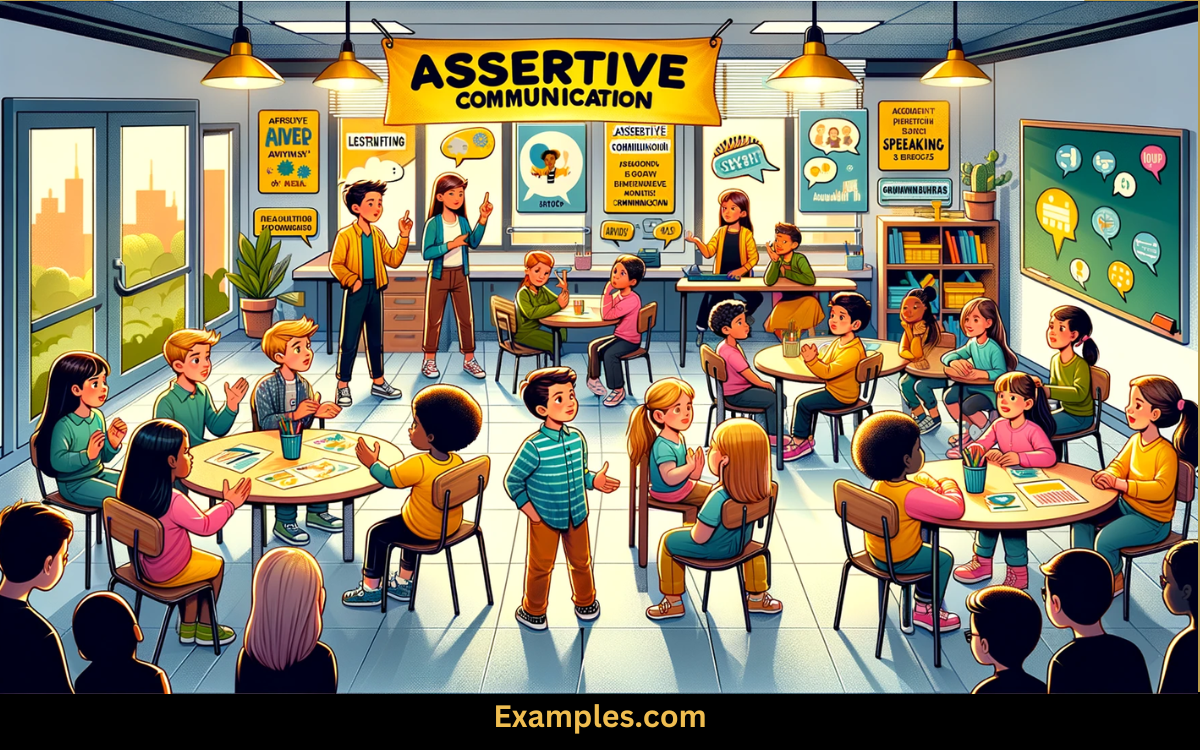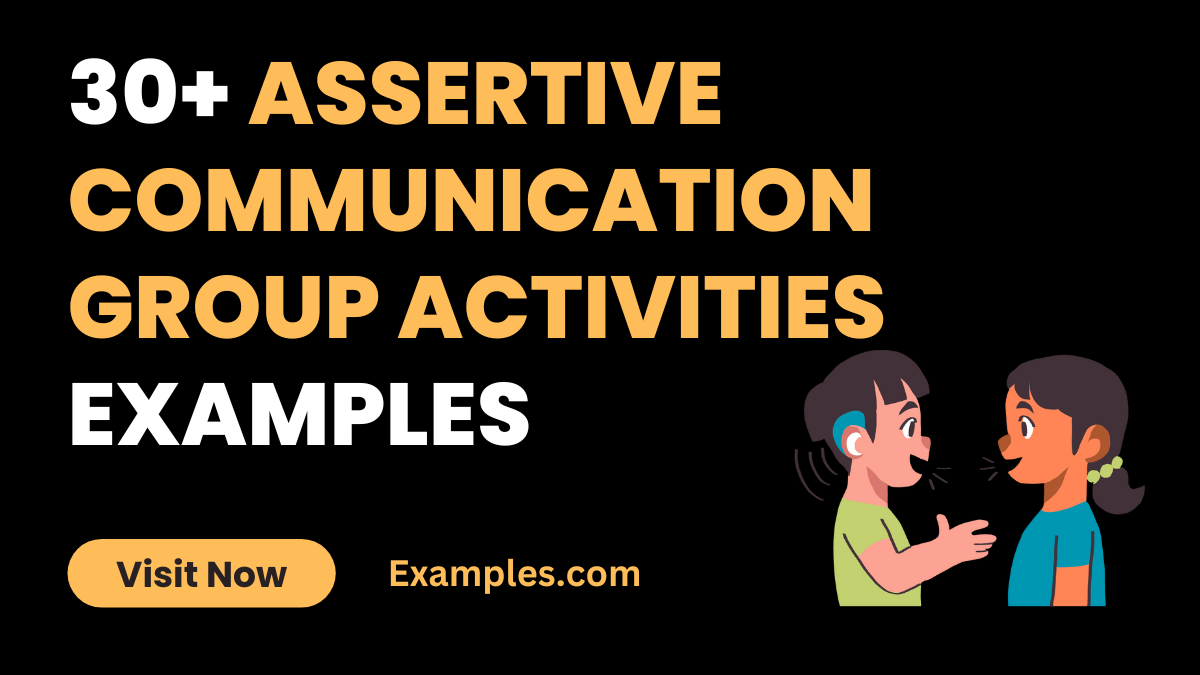19+ Assertive Communication Group Activities Examples
Welcome to our comprehensive guide on Assertive Communication Group Activities, where we delve into the art of expressing oneself confidently and respectfully. With a focus on practical communication examples, this guide is designed to enhance your ability to communicate effectively in various scenarios. Whether you’re seeking to improve personal relationships or professional interactions, these activities and examples will provide you with the tools to communicate assertively, fostering a balance of empathy and firmness in your daily exchanges.
30 Examples of Assertive Communication Group Activities
Embark on a journey to master the art of assertive communication with our curated list of 30 unique activities. These examples, rich in practical insights, are designed to enhance your communication skills, ensuring clarity and respect in every interaction. From personal dialogues to professional discussions, these activities will equip you with the techniques to express yourself assertively, fostering effective and harmonious communications. Dive in and discover how to navigate various situations with confidence and poise.
- Role-Playing Difficult Conversations: Practice handling challenging scenarios with a partner, focusing on maintaining a calm demeanor and clear message. This prepares you for real-life tough talks with confidence.
- Active Listening Exercises: Partner up and practice fully listening to each other’s points without interrupting, demonstrating empathy and understanding before responding.
- I Statement Formulation: Craft statements starting with “I feel…” to express your emotions and needs without placing blame, fostering a non-confrontational dialogue.
- Empathy Mapping: Visualize the other person’s perspective in conflicts to develop a deeper understanding and respond more empathetically in assertive communication.
- Feedback Sandwich Method: Give constructive feedback by starting and ending with positive comments, sandwiching the area of improvement in the middle.
- Boundary Setting Role Play: Practice scenarios where you assertively set personal or professional boundaries, emphasizing respect for both parties’ needs.
- Conflict Resolution Scenario Practice: Engage in mock scenarios to practice resolving conflicts with assertiveness, focusing on finding mutually beneficial solutions.
- Body Language Awareness: Work on aligning your body language with your words to convey assertiveness, such as maintaining eye contact and an open stance.
- Emotional Control Techniques: Learn to manage emotions during conversations, ensuring they don’t overpower the message you intend to communicate assertively.
- Positive Affirmation Practice: Regularly affirm your right to express opinions and needs, boosting confidence in assertive communication.
- Constructive Criticism Role-Playing: Practice giving and receiving constructive criticism, focusing on growth and improvement.
- Calm Response Drills: In stressful conversation simulations, practice responding calmly and assertively rather than reacting impulsively.
- Assertive Sentence Construction: Develop assertive sentences for common scenarios, emphasizing clarity and directness while being respectful.
- Non-Verbal Cue Recognition: Learn to read and respond to non-verbal cues in others, enhancing your assertive communication skills.
- Solution-Oriented Discussion Exercises: Focus discussions on finding solutions rather than dwelling on problems, encouraging a positive and assertive communication style.
- Declining Requests Assertively: Practice politely and firmly declining requests that don’t align with your priorities or capabilities.
- Sharing Opinions Openly: Engage in exercises that encourage openly sharing opinions, even when they differ from the majority, in a respectful manner.
- Requesting Needs and Wants: Develop the skill to assertively express your needs and wants in various settings, from personal to professional.
- Handling Criticism Gracefully: Engage in activities that teach you to receive criticism constructively, responding assertively and without defensiveness.
- Clarifying Misunderstandings: Practice scenarios where you clarify misunderstandings assertively, ensuring clear and effective communication.
- Public Speaking with Assertiveness: Develop public speaking skills that emphasize assertiveness, combining clear expression with confident body language.
- Empathetic Listening in Group Discussions: Practice listening with empathy in group settings, ensuring everyone feels heard and respected.
- Respectful Disagreement in Debates: Engage in debates where you practice disagreeing respectfully, maintaining an assertive yet considerate tone.
- Firm Boundary Setting in Personal Relationships: Learn to set and communicate boundaries assertively in personal relationships, balancing firmness with care.
- Direct Communication in Work Meetings: Practice being direct and clear in work meetings, ensuring your points are conveyed assertively and respectfully.
- Handling Assertive Communication in High-pressure Situations: Simulate high-pressure situations to practice maintaining assertiveness under stress.
- Negotiating Compromises in Team Projects: Work on negotiating compromises assertively in team projects, balancing individual and group needs.
- Asking for Help Confidently: Develop the skill to ask for help assertively, showing strength in acknowledging your needs.
- Communicating Needs in Healthcare Settings: Practice assertively communicating your healthcare needs to professionals, ensuring your well-being is prioritized.
- Assertive Email Writing Techniques: Learn to write emails that are clear, direct, and assertive, effectively conveying your message without ambiguity.
Top 20 Assertive Communication Activities
In today’s fast-paced and diverse world, mastering assertive communication is essential. This comprehensive guide presents the Top 20 Assertive Communication Activities, optimized to enhance your ability to communicate effectively, confidently, and respectfully in various situations. These activities are not just exercises but are pivotal in shaping a more assertive you, contributing to both personal growth and professional success.

- Mindful Speaking Drills: Focus on mindful speaking where you consciously choose words that are clear and direct, yet respectful. This drill enhances your ability to articulate thoughts without aggression.
- Assertive Posture Practice: Engage in exercises that focus on maintaining an assertive posture – standing tall, maintaining eye contact, and using open hand gestures. This reinforces the importance of body language in assertive communication.
- Scenario-Based Communication Challenges: Participate in various scenario-based challenges that simulate real-life situations, requiring you to practice assertive communication strategies effectively.
- Group Dynamics and Assertive Interaction: Work in groups to practice assertive interactions, understanding how to express oneself effectively while respecting others’ viewpoints.
- Effective Use of ‘I’ Statements: Learn to frame your sentences using ‘I’ statements to express your feelings and needs without blaming or offending others.
- Empathetic Listening and Responding: Practice listening empathetically to others and respond assertively, ensuring a balanced and respectful conversation.
- Assertive Negotiation Simulations: Engage in role-playing activities that simulate negotiation scenarios, focusing on assertive communication to reach mutually beneficial outcomes.
- Constructive Confrontation Exercises: Learn how to confront issues constructively using assertive communication, addressing problems directly while maintaining a respectful tone.
- Personal Rights Awareness Sessions: Conduct sessions to become aware of your personal rights and how to assert them in communication without infringing on others’ rights.
- Assertive Communication in Digital Media: Practice assertive communication in digital media, focusing on how to convey clear, respectful, and assertive messages in written form.
- Resilience Building Through Assertive Responses: Develop resilience by practicing how to respond assertively in challenging and high-pressure situations.
- Assertive Feedback in Peer Groups: Practice giving and receiving feedback in peer groups assertively, focusing on honesty and constructive criticism.
- Non-Verbal Communication Cues Awareness: Enhance awareness of non-verbal cues and how they can be used to complement assertive verbal communication.
- Reflection and Self-Assessment Exercises: Reflect on personal communication styles and assess areas for improvement in assertiveness.
- Assertive Communication in Conflict Resolution: Learn and practice strategies for assertive communication specifically tailored for conflict resolution.
- Understanding the Spectrum of Communication Styles: Understand different communication styles – passive, aggressive, passive-aggressive, and assertive – and learn to adapt to assertive communication.
- Role-Playing Assertive Communication in Various Roles: Role-play different roles and situations (e.g., manager-employee, parent-child) to understand the nuances of assertive communication in different contexts.
- Time Management and Assertive Communication: Learn how effective time management can aid in more assertive and organized communication.
- Cultural Sensitivity in Assertive Communication: Understand and practice how to be assertively communicative while being culturally sensitive and respectful.
- Assertive Communication for Self-Advocacy: Practice scenarios where you advocate for your needs and rights assertively, emphasizing the importance of self-advocacy in personal and professional life.
Assertive Communication Group Activities for Kids
Introduce children to the world of assertive communication with these 10 activities. These fun and interactive exercises are tailored for kids, helping them learn to express themselves clearly and respectfully. They offer a foundation in building confidence and understanding the importance of respectful communication from a young age.

- Expressing Feelings with Colors and Shapes: Encourage kids to use colors and shapes to express their emotions, fostering an understanding of assertive emotional expression.
- Storytelling with Assertive Characters: Read stories featuring assertive characters, discussing how they express themselves and solve problems.
- Role-Playing Classroom Scenarios: Children can role-play various classroom situations, practicing assertive communication with peers and teachers.
- ‘I Feel’ Jar Activity: Create a jar where kids can drop notes describing how they feel about different situations, promoting open and assertive expression.
- Assertive Communication Through Puppetry: Use puppets to act out scenarios, teaching kids how to assertively express themselves in different contexts.
- Building Confidence with Affirmation Cards: Use affirmation cards to boost children’s self-esteem and confidence in assertive communication.
- Practicing Polite Requests and Refusals: Teach kids how to politely request what they need and assertively say no when necessary.
- Assertive Body Language Games: Engage in games that emphasize confident body language, such as standing tall or making eye contact.
- ‘What Would You Do?’ Scenarios: Present hypothetical scenarios and discuss assertive ways to handle them, enhancing problem-solving and communication skills.
- Expressing Needs and Wishes Activity: Encourage children to openly express their needs and wishes, teaching the importance of clear, assertive communication.
Assertive Communication Group Activities for Students
Tailored for the educational environment, these 10 assertive communication activities for students aim to boost their confidence and competence in expressing themselves. From classroom discussions to group projects, these exercises prepare students to communicate their ideas and opinions assertively and respectfully, vital for both academic and personal growth.

- Debate Clubs with Constructive Feedback Sessions: Participate in debates and provide constructive feedback, fostering assertive expression and receptive listening.
- Group Discussion Leadership Roles: Rotate leadership roles in group discussions to practice assertive communication and effective group management.
- Assertive Communication in Peer Review Sessions: Engage in peer reviews where students practice giving and receiving feedback assertively and constructively.
- Classroom Negotiation Simulations: Simulate negotiation scenarios in the classroom, teaching students how to assertively advocate for their positions.
- Public Speaking and Presentation Skills Workshops: Conduct workshops focused on developing assertive public speaking and presentation skills.
- Assertive Email and Letter Writing Exercises: Practice writing assertive and respectful emails and letters, especially in academic or professional contexts.
- Conflict Resolution Workshops: Offer workshops on conflict resolution, emphasizing assertive communication as a key tool.
- Assertive Goal Setting and Sharing Sessions: Encourage students to set personal goals and share them assertively with their peers.
- Respectful Argumentation Techniques: Teach techniques for arguing points respectfully and assertively, essential for academic discussions.
- Assertive Communication in Group Projects: Focus on assertive communication skills in group project settings, ensuring everyone’s ideas are heard and respected.
How Can You Practice Assertive Communication?
Practicing assertive communication is essential for effective interpersonal interactions. To develop this skill, focus on several key areas:
- Self-Awareness: Begin by understanding your communication style. Reflect on past interactions and identify moments where you were passive, aggressive, or assertive. Self-awareness is the foundation for growth in assertive communication.
- Understand Assertive Communication Principles: Learn the characteristics of assertive communication, such as clarity, respect, directness, and empathy. Knowing these principles helps in applying them in real-life situations.
- Develop Active Listening Skills: Assertiveness is not just about expressing yourself; it’s also about understanding others. Practice active listening by paying full attention, nodding, and summarizing what the other person says.
- Role-Playing: Simulate various conversational scenarios with a friend or in front of a mirror. Practice how you would respond assertively in different situations.
- Feedback Seeking: After conversations, ask for feedback from trusted individuals about your communication style. Constructive criticism helps in fine-tuning your assertive communication skills.
- Mindfulness and Emotional Regulation: Being mindful of your emotions during conversations helps in maintaining an assertive stance. Practice emotional regulation techniques like deep breathing to stay calm and composed.
- Assertive Body Language: Work on your body language. Practice maintaining eye contact, a confident posture, and gestures that convey openness and assertiveness.
What Are the Best Assertive Communication Group Activities and Techniques?
To enhance assertive communication skills, engaging in specific activities and techniques can be highly beneficial:
- I Statements: Use “I” statements to express your feelings and thoughts without blaming or criticizing others. For example, “I feel concerned when meetings start late.”
- Positive Affirmation and Self-Talk: Positive affirmations can build self-esteem, a critical aspect of assertive communication. Engage in positive self-talk daily to reinforce your self-worth and confidence.
- Assertive Communication Workshops: Participate in workshops or training sessions focusing on assertive communication. These often provide practical exercises and feedback from communication experts.
- Journaling: Reflect on your daily interactions by journaling. Write about situations where you communicated effectively or times when you could have been more assertive.
- Setting Personal Boundaries: Practice setting and communicating your personal boundaries to others. Being clear about your limits is a crucial aspect of assertive communication.
- Empathy Exercises: Develop empathy by trying to understand things from others’ perspectives. This enhances your ability to communicate assertively without disregarding others’ feelings.
- Constructive Feedback Practice: Give and receive feedback regularly in a constructive manner. This helps in developing a balanced approach to assertive communication.
- Conflict Resolution Role-Play: Engage in role-play exercises that simulate conflict scenarios. Practice resolving these conflicts assertively and respectfully.
- Assertive Negotiation Techniques: Learn and practice negotiation techniques where you assert your needs while also considering the needs of others.
- Scenario-Based Learning: Use real or hypothetical scenarios to practice assertive communication. Analyze each scenario and discuss or write about how you would handle them assertively.
As you conclude your exploration of assertive communication activities, remember that these skills are not just about speaking up; they are about creating a balanced dialogue where respect and understanding are paramount. Whether in personal relationships or professional settings, assertive communication paves the way for healthier and more effective interactions.
By regularly practicing these activities, you can develop a communication style that is both firm and empathetic, empowering you to express your thoughts and needs clearly and respectfully. To further enrich your understanding, consider exploring additional resources such as the American Psychological Association’s guidelines on assertive communication here and Harvard University’s insights into effective communication skills here. These external resources offer valuable perspectives and techniques to enhance your assertive communication journey.



